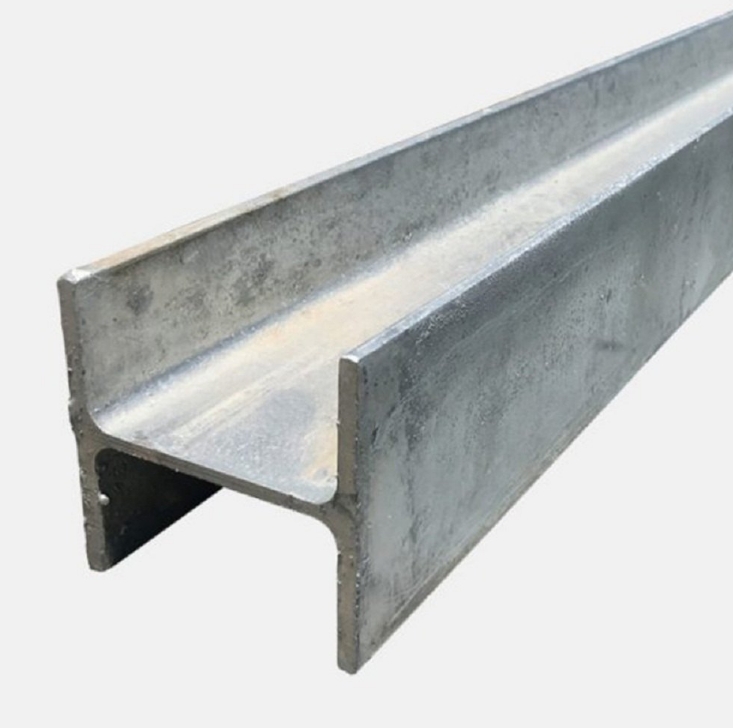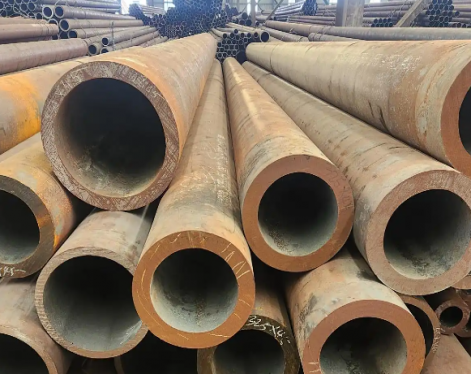H steel beams are made in the production and processing area, and welded H-shaped steel beams are made uniformly in the h steel beams factory and exporter. The steel beam production process is as follows:Raw material correction→setting out→numbering→blanking→parts processing and welding→sandblasting and rust removal→painting.
Table 1
Before cutting, the surface of the steel cutting area should be cleaned of rust, dirt, etc. When cutting and blanking, the workpiece should be placed on a special flat bracket to ensure that the workpiece does not tilt or shake and reduce blanking errors. The allowable deviation of cutting shall comply with the provisions of Table 2 and the quality of the cutting surface shall comply with the provisions.
Table 2
When welding long welds, use the reverse reverse welding method or the layered reverse reverse welding method. During manual arc welding, multiple welders are used to weld symmetrically at the same time to eliminate welding deformation as much as possible. At the same time, short arc welding is used to prevent air from intruding into the welding area and causing cracks and pores in the weld metal.

After welding is completed, the welder should clean the slag on the surface of the weld and check the appearance quality of the weld. The outer dimensions of the weld should comply with the current national standard "Outline Dimensions of Steel Structure Welds". The T-shaped connection welds between the upper and lower flange plates and the web of the H-shaped steel beam should be fully welded, and its appearance inspection and non-destructive inspection should comply with its design requirements and relevant quality standards.
In order to prevent or reduce welding deformation, welding should be carried out strictly according to the established welding process. After welding, the welded H-shaped steel should be placed on the section steel straightening machine for correction. The allowable deviation of welded H-shaped steel should comply with the provisions of Table 3.
Table 3
3.1 Rust removal
The steel structure uses sandblasting to remove rust and complies with the relevant regulations. The relative humidity of the construction environment should not be greater than 85%. The workpiece after derusting must be polished with a grinding wheel to remove all welding nodules, spatter, and the hardened layer of the flame correction area on the surface of the workpiece before proceeding to the next process. Rust needs to be removed again.
3.2 Application
After the rust removal of the steel is inspected and passed, the first primer should be applied to the surface. Generally, the primer should be applied within 24 hours after the rust removal is completed. The paint should be used in accordance with the design requirements. After the first coat of primer is dry, the intermediate paint and topcoat should be applied to ensure that the coating thickness meets the design requirements. The paint should be applied evenly and not smear during application.
(1)Construction preparation
Choose paint according to the requirements of the design drawings.
Prepare rust removal machinery and painting tools.
Before painting, the steel structure and components have been inspected and accepted and meet the design requirements.
(2)Coating construction
Base surface cleaning: Before brushing, clean away rust, weld coating, welding spatter, oil, dust and other debris in the parts to be painted.Blend the paint, control the viscosity, consistency, and dilution of the paint, and stir thoroughly when mixing to make the paint color and viscosity uniform.When applying the first coat of paint, the painting direction should be consistent and the paint should be applied neatly.After the first coat is dry, apply the second coat. The direction of the second coat of paint should be perpendicular to the direction of the first coat. This will make the thickness of the paint film uniform.After painting, mark the components according to their original numbers: major components also need to be marked with weight, center of gravity position and positioning number.
(3)Coating inspection and acceptance
During and after surface coating construction, the painted workpieces should be protected from flying dust and other debris. After-painting inspection, the coating should be consistent in color, bright in color, bright, wrinkle-free, and pimple-free.
1. Staking out and cutting materials
Accurately calculate the cutting length of the steel beam based on the measured and reviewed frame column and beam axes. Cut the material to ensure the cut is flat and vertical. When the section steel needs to be extended, the 45° connection method is used, and the flange plate and web joints are staggered. When setting out, the welding shrinkage allowance during production and installation and the processing allowance for cutting, planing and other processing should be reserved according to the process requirements. The allowable deviation for setting out shall comply with the provisions of Table 1.Table 1
| Item | Allowable Deviation |
|---|---|
| Parallel Line Distance and Segment Size | ±0.5 |
| Diagonal Difference | 1.0 |
| Width, Length | ±0.5 |
| Hole Spacing | ±0.5 |
| Angle of Processed Template | ±20 |
Before cutting, the surface of the steel cutting area should be cleaned of rust, dirt, etc. When cutting and blanking, the workpiece should be placed on a special flat bracket to ensure that the workpiece does not tilt or shake and reduce blanking errors. The allowable deviation of cutting shall comply with the provisions of Table 2 and the quality of the cutting surface shall comply with the provisions.
Table 2
| Item | Allowable Deviation (mm) |
|---|---|
| Component Width, Length | ±3.0 |
| Surface Flatness of the Cutting Process | 0.05t but not greater than 2.0 |
| Scoring Depth | 0.2 |
| Local Notch Depth | 1.0 |
2. Steel beam assembly and welding
Before assembling the H-shaped steel beam, check whether the web and flange plates need to be corrected. Only when they are qualified can assembly and welding be carried out. Welding mainly uses (semi-)automatic welding machines, combined with manual arc welding. Before welding, the welder should review the joint quality of the weldment and the treatment of the welding area. If it does not meet the requirements, it should be repaired and qualified before welding. Do not use damp flux or rusty welding wire.When welding long welds, use the reverse reverse welding method or the layered reverse reverse welding method. During manual arc welding, multiple welders are used to weld symmetrically at the same time to eliminate welding deformation as much as possible. At the same time, short arc welding is used to prevent air from intruding into the welding area and causing cracks and pores in the weld metal.

After welding is completed, the welder should clean the slag on the surface of the weld and check the appearance quality of the weld. The outer dimensions of the weld should comply with the current national standard "Outline Dimensions of Steel Structure Welds". The T-shaped connection welds between the upper and lower flange plates and the web of the H-shaped steel beam should be fully welded, and its appearance inspection and non-destructive inspection should comply with its design requirements and relevant quality standards.
In order to prevent or reduce welding deformation, welding should be carried out strictly according to the established welding process. After welding, the welded H-shaped steel should be placed on the section steel straightening machine for correction. The allowable deviation of welded H-shaped steel should comply with the provisions of Table 3.
Table 3
| Project | Permissible Deviation (mm) |
|---|---|
| Component Width, Length | ±3.0 |
| Surface Flatness of Cut Face | 0.05t and not greater than 2.0 |
| Scoring Depth | 0.2 |
| Local Notch Depth | 1.0 |
3. Steel beam rust removal and coating
The surface of the components will be rust-removed and painted. Only the rust will be removed within 100mm from the on-site welding seam. No painting will be done for the time being. After the on-site welding is completed, re-painting will be carried out according to the original painting requirements.3.1 Rust removal
The steel structure uses sandblasting to remove rust and complies with the relevant regulations. The relative humidity of the construction environment should not be greater than 85%. The workpiece after derusting must be polished with a grinding wheel to remove all welding nodules, spatter, and the hardened layer of the flame correction area on the surface of the workpiece before proceeding to the next process. Rust needs to be removed again.
3.2 Application
After the rust removal of the steel is inspected and passed, the first primer should be applied to the surface. Generally, the primer should be applied within 24 hours after the rust removal is completed. The paint should be used in accordance with the design requirements. After the first coat of primer is dry, the intermediate paint and topcoat should be applied to ensure that the coating thickness meets the design requirements. The paint should be applied evenly and not smear during application.
(1)Construction preparation
Choose paint according to the requirements of the design drawings.
Prepare rust removal machinery and painting tools.
Before painting, the steel structure and components have been inspected and accepted and meet the design requirements.
(2)Coating construction
Base surface cleaning: Before brushing, clean away rust, weld coating, welding spatter, oil, dust and other debris in the parts to be painted.Blend the paint, control the viscosity, consistency, and dilution of the paint, and stir thoroughly when mixing to make the paint color and viscosity uniform.When applying the first coat of paint, the painting direction should be consistent and the paint should be applied neatly.After the first coat is dry, apply the second coat. The direction of the second coat of paint should be perpendicular to the direction of the first coat. This will make the thickness of the paint film uniform.After painting, mark the components according to their original numbers: major components also need to be marked with weight, center of gravity position and positioning number.
(3)Coating inspection and acceptance
During and after surface coating construction, the painted workpieces should be protected from flying dust and other debris. After-painting inspection, the coating should be consistent in color, bright in color, bright, wrinkle-free, and pimple-free.









